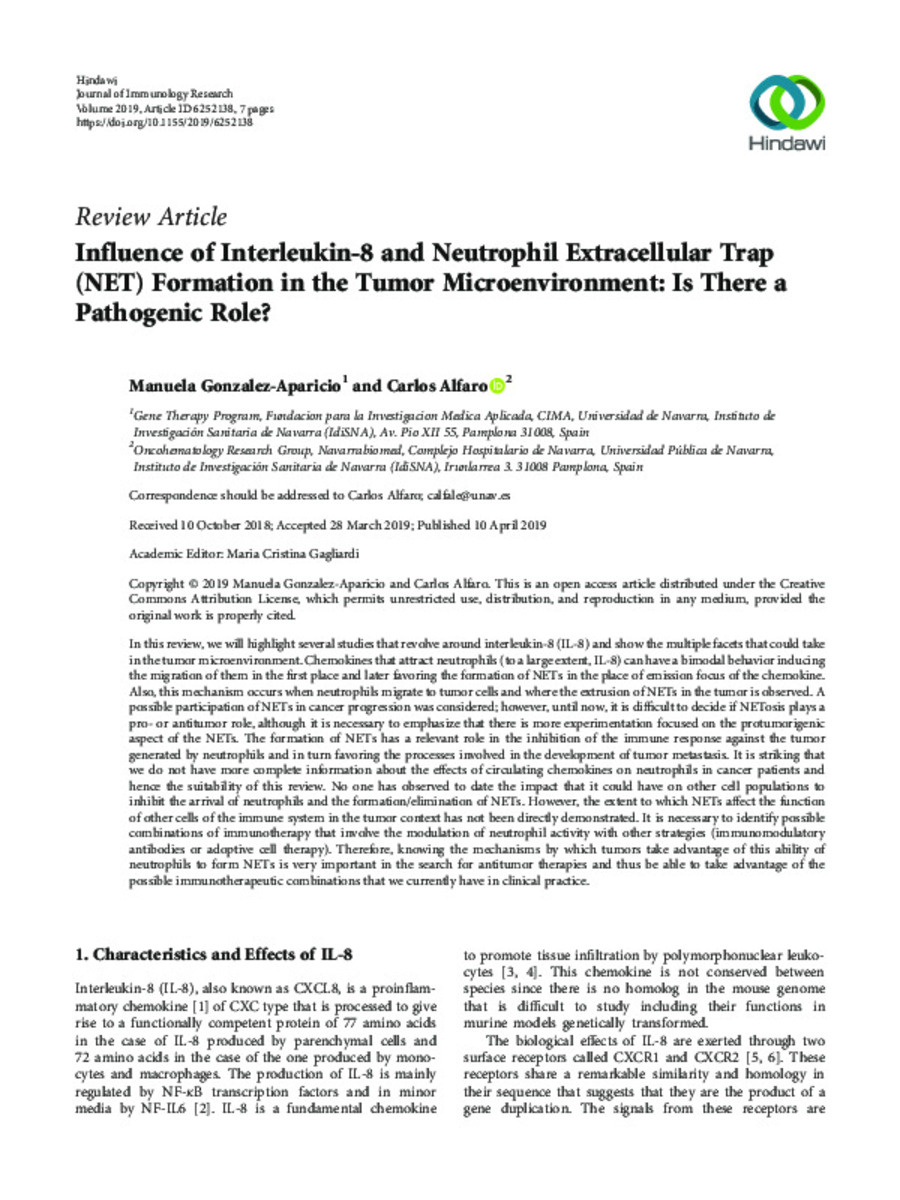Full metadata record
| DC Field | Value | Language |
|---|---|---|
| dc.creator | Gonzalez-Aparicio, M. (Manuela) | - |
| dc.creator | Alfaro, C. (Carlos) | - |
| dc.date.accessioned | 2021-11-04T08:34:56Z | - |
| dc.date.available | 2021-11-04T08:34:56Z | - |
| dc.date.issued | 2019 | - |
| dc.identifier.citation | Gonzalez-Aparicio, M. (Manuela); Alfaro, C. (Carlos). "Influence of interleukin-8 and neutrophil extracellular trap (NET) formation in the tumor microenvironment: is there a pathogenic role?". Journal of Immunology Research. 2019, 2019, 6252138 | es_ES |
| dc.identifier.issn | 2314-7156 | - |
| dc.identifier.uri | https://hdl.handle.net/10171/62316 | - |
| dc.description.abstract | In this review, we will highlight several studies that revolve around interleukin-8 (IL-8) and show the multiple facets that could take in the tumor microenvironment. Chemokines that attract neutrophils (to a large extent, IL-8) can have a bimodal behavior inducing the migration of them in the first place and later favoring the formation of NETs in the place of emission focus of the chemokine. Also, this mechanism occurs when neutrophils migrate to tumor cells and where the extrusion of NETs in the tumor is observed. A possible participation of NETs in cancer progression was considered; however, until now, it is difficult to decide if NETosis plays a pro- or antitumor role, although it is necessary to emphasize that there is more experimentation focused on the protumorigenic aspect of the NETs. The formation of NETs has a relevant role in the inhibition of the immune response against the tumor generated by neutrophils and in turn favoring the processes involved in the development of tumor metastasis. It is striking that we do not have more complete information about the effects of circulating chemokines on neutrophils in cancer patients and hence the suitability of this review. No one has observed to date the impact that it could have on other cell populations to inhibit the arrival of neutrophils and the formation/elimination of NETs. However, the extent to which NETs affect the function of other cells of the immune system in the tumor context has not been directly demonstrated. It is necessary to identify possible combinations of immunotherapy that involve the modulation of neutrophil activity with other strategies (immunomodulatory antibodies or adoptive cell therapy). Therefore, knowing the mechanisms by which tumors take advantage of this ability of neutrophils to form NETs is very important in the search for antitumor therapies and thus be able to take advantage of the possible immunotherapeutic combinations that we currently have in clinical practice. | es_ES |
| dc.language.iso | eng | es_ES |
| dc.publisher | Hindawi Limited | es_ES |
| dc.rights | info:eu-repo/semantics/openAccess | es_ES |
| dc.subject | Interleukin-8 (IL-8) | es_ES |
| dc.subject | Tumor microenvironment | es_ES |
| dc.subject | Neutrophils | es_ES |
| dc.subject | NETs | es_ES |
| dc.title | Influence of interleukin-8 and neutrophil extracellular trap (NET) formation in the tumor microenvironment: is there a pathogenic role? | es_ES |
| dc.type | info:eu-repo/semantics/article | es_ES |
| dc.description.note | This is an open access article distributed under the Creative Commons Attribution License | es_ES |
| dc.identifier.doi | 10.1155/2019/6252138 | - |
| dadun.citation.publicationName | Journal of Immunology Research | es_ES |
| dadun.citation.startingPage | 6252138 | es_ES |
| dadun.citation.volume | 2019 | es_ES |
Files in This Item:
Statistics and impact
Items in Dadun are protected by copyright, with all rights reserved, unless otherwise indicated.






